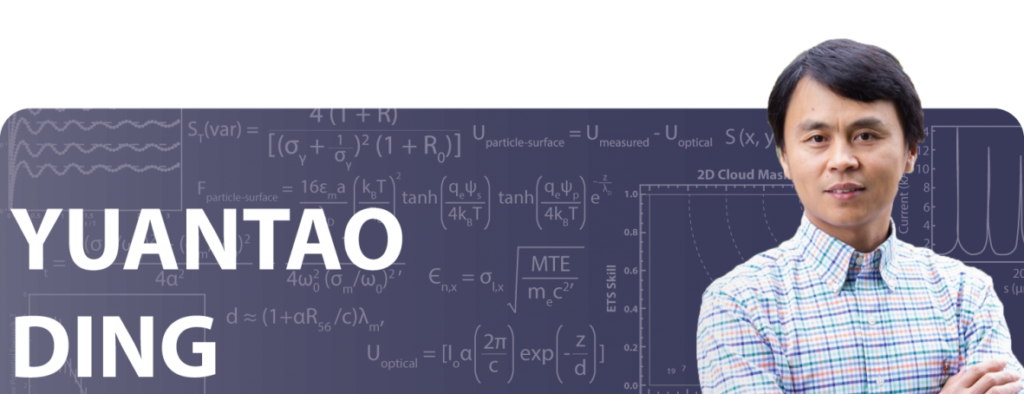WHAT DID THE 2010 EARLY CAREER AWARD ALLOW YOU TO DO?
The Linac Coherent Light Source (LCLS) at the SLAC National Accelerator Laboratory provides powerful flashes of X-ray light that is 10 billion times brighter than those available before. Besides the improved brightness, these X-ray pulses are also super short, with each one lasting just few quadrillionths of a second, or “femtoseconds”. This is a unique tool able to capture snapshot images of the motion of atoms in molecules, providing revolutionary views of some of nature’s fastest phenomena on the smallest scale. Beyond the femtosecond science, even shorter probes —at the sub-femtosecond (or attosecond) scale—are highly desired to allow tracking the motion of electrons as they cross single chemical bonds in less than a single femtosecond.
With the support of the 2010 Early Career Award, we investigated schemes at the LCLS for controlling the X-ray free-electron laser pulse duration at the femtosecond scale, and explored methods for shortening the pulses down to the sub-femtosecond regime.
At the same time, another challenging topic is to measure these short pulses. We proposed and implemented several techniques for measuring the duration of the electron bunches and the X-ray pulses at the LCLS. One of them is a transverse deflecting cavity-based method, providing an online shot-by-shot pulse duration diagnostic with about one femtosecond resolution.
The achievements during this Early Career Award research period have directly benefited the LCLS user facility operation and performance improvement and also have had positive impacts on other free-electron laser facilities around the world.
ABOUT:
Yuantao Ding is a staff scientist at the Department of Energy’s SLAC National Accelerator Laboratory.
SUPPORTING THE DOE SC MISSION:
The Early Career Award program provides financial support that is foundational to young scientists, freeing them to focus on executing their research goals. The development of outstanding scientists early in their careers is of paramount importance to the Department of Energy Office of Science. By investing in the next generation of researchers, the Office of Science champions lifelong careers in discovery science.
For more information, please go to the Early Career Research Program.
THE 2010 PROJECT ABSTRACT:
Generation and Characterization of Ultra‐short electron beams for X-ray free electron lasers
The goal of this project is to develop mechanisms for generating ultra‐short X‐ray pulses that will enable the study of ultra‐fast processes, such as the motion of atoms in molecules or the electronic motions in atoms. This research will investigate ultra‐short electron beam generation and characterization utilizing analytical, computational, and experimental methods. Free‐electron lasers (FELs) are tunable, high power, coherent sources for short‐pulse, short‐wavelength radiation. Short X‐ray pulses will enable the ability to photograph atomic motion or to trace the dynamics of molecular structure. The generation of even shorter X‐ray pulses (“ultra‐short”) is a formidable challenge requiring theoretical and experimental breakthroughs. Shorter X-ray pulses, like a few femto‐seconds or atto‐seconds, will allow for the direct observation of electronic motion in an atom and enable many new ultrafast studies such as time‐resolved electronic dynamics, with widespread applications in physics, chemistry and biology.
RESOURCES:
Y. Ding, C. Behrens, R. Coffee, F.J. Decker, P. Emma, C. Field, W. Helml, Z. Huang, P. Krejcik, J. Krzywinski, H. Loos, A. Lutman, A. Marinelli, T.J. Maxwell, and J. Turner, “Generating femtosecond X-ray pulses using an emittance-spoiling foil in free- electron lasers.” Applied Physics Letters 107, 191104 (2015). [DOI: 10.1063/1.4935429]
C. Behrens, F.J. Decker, Y. Ding, V.A. Dolgashev, J. Frisch, Z. Huang, P. Krejcik, H. Loos, A. Lutman, T.J. Maxwell, J. Turner, J. Wang, M.H. Wang, J. Welch, and J. Wu, “Few-femtosecond time-resolved measurements of X-ray free-electron lasers.” Nature Communications 5, 3762 (2014). [DOI: 10.1038/ncomms4762]
Y. Ding, F.J. Decker, P. Emma, C. Feng, C. Field, J. Frisch, Z. Huang, J. Krzywinski, H. Loos, J. Welch, J. Wu and F. Zhou, “Femtosecond X-ray pulse characterization in free- electron lasers using a cross-correlation technique.” Phys. Rev. Lett. 109, 254802 (2012). [DOI: 10.1103/PhysRevLett.109.254802]
Additional profiles of the 2010 Early Career Award winners can be found at: https://www.energy.gov/science/listings/early-career-program.
The Office of Science is the single largest supporter of basic research in the physical sciences in the United States and is working to address some of the most pressing challenges of our time. For more information, please visit www.energy.gov/science.
Original post https://alertarticles.info
